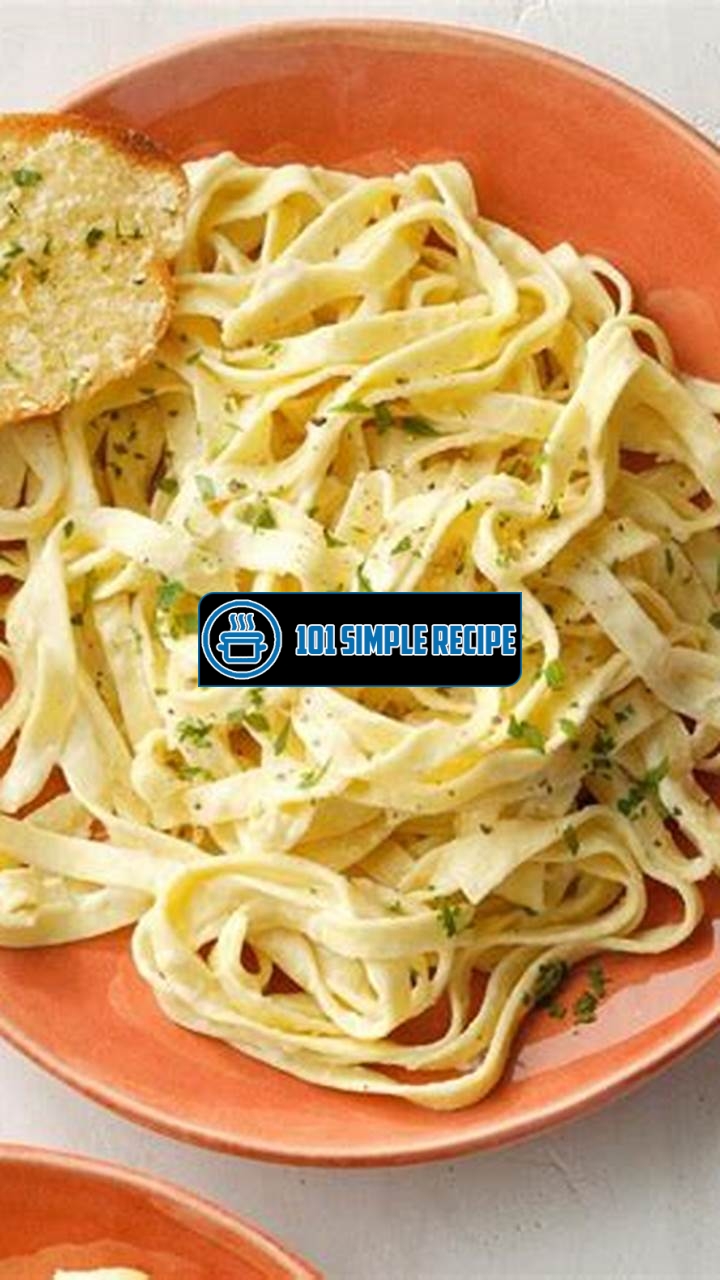Savor the richness of the best Fettuccine Alfredo recipe and indulge in a creamy, cheesy delight that will leave your taste buds craving for more. This iconic Italian pasta dish, consisting of fettuccine noodles smothered in a luscious Parmesan cheese sauce, is a culinary masterpiece that is both comforting and luxurious. Whether you are a fan of traditional recipes or looking to put your own unique twist on a classic, this article will guide you step-by-step towards creating a Fettuccine Alfredo that is sure to impress. So, put on your apron and get ready to embark on a gastronomic journey that will tantalize your senses with every bite.

Understanding Nutmeg in Fettuccine Alfredo
Discover the role of nutmeg in enhancing the flavor of the classic Fettuccine Alfredo dish. Nutmeg is a widely used spice in Italian cuisine, known for its warm and aromatic flavor. It is often added to various dishes to elevate their taste, including the popular Fettuccine Alfredo.
The Origins of Nutmeg in Italian Cuisine
Nutmeg has a rich history in Italian cuisine, tracing its roots back to the ancient spice trade routes. It was highly valued and sought after for its unique flavor and aromatic properties. In Italy, nutmeg was introduced during the medieval period and quickly became a staple in various dishes, including pasta.
Italian cuisine is known for its emphasis on simple yet flavorful ingredients, and nutmeg perfectly aligns with this philosophy. It adds a distinctive warmth and depth to dishes, making them more enjoyable and satisfying.
The Flavor Profile of Nutmeg
Nutmeg has a complex flavor profile that consists of both sweet and savory notes. It has a slightly sweet and nutty taste with hints of cinnamon and clove. When used in moderation, nutmeg can enhance the overall flavor of a dish without overpowering it.
The aroma of nutmeg is equally captivating. It is warm, woody, and slightly spicy, adding depth to the olfactory experience of any culinary creation. Nutmeg is often grated or ground just before use to preserve its delicate aroma and flavor.
How Nutmeg Elevates Fettuccine Alfredo
Nutmeg plays a vital role in elevating the flavor profile of Fettuccine Alfredo. When added to the dish, it enhances the creamy and cheesy flavors, creating a harmonious balance of taste. The warm and aromatic notes of nutmeg complement the richness of the Alfredo sauce, giving it a unique and delightful twist.
Furthermore, nutmeg contributes to the overall complexity and depth of the dish. Its subtle sweetness and hints of spice add layers of flavor, making each bite a culinary delight. Nutmeg also helps to cut through the richness of the Alfredo sauce, preventing it from becoming overwhelming.
In conclusion, nutmeg is a key ingredient in the best Fettuccine Alfredo recipe. Its rich history in Italian cuisine, along with its unique flavor profile, makes it a perfect addition to this classic dish. So, the next time you savor a plate of Fettuccine Alfredo, take a moment to appreciate the role of nutmeg in enhancing its richness and depth of flavor.
If you’re in the mood for a refreshing drink to pair with your fettuccine alfredo, try this delicious punch bowl recipe. It’s the perfect way to add some fruity sweetness to your meal!
Choosing the Right Ingredients
When it comes to creating the best Fettuccine Alfredo, choosing the right ingredients is crucial. Each component contributes to the overall flavor and texture of the dish. In this section, we will explore three key ingredients that will help you create the perfect Fettuccine Alfredo recipe with a touch of nutmeg.
High-quality Parmesan Cheese: The Star Ingredient
Parmesan cheese is the star ingredient of Fettuccine Alfredo, adding a rich and savory flavor to the dish. It is important to choose a high-quality Parmesan cheese for the best results. Look for Parmigiano-Reggiano, a protected designation of origin (PDO) cheese from Italy. This cheese is aged for at least 12 months, giving it a distinctive taste and texture.
When grating the Parmesan cheese, make sure to use a microplane grater for a fine and fluffy texture. This will ensure that the cheese melts smoothly into the sauce, creating a creamy and delicious result.
Tip: To enhance the flavor profile of your Fettuccine Alfredo, add a pinch of freshly ground nutmeg to the Parmesan cheese. The nutmeg will add a subtle warmth and depth of flavor to the dish.
Fresh Fettuccine Pasta: The Perfect Base
The fettuccine pasta is the foundation of the dish, providing the perfect base for the rich and creamy Alfredo sauce. Fresh pasta works best for this recipe, as it has a tender texture and cooks quickly.
If you have the time and resources, consider making your own fettuccine pasta from scratch. This will allow you to control the thickness and width of the pasta, ensuring that it perfectly complements the sauce. However, if you prefer convenience, you can also find fresh fettuccine pasta in the refrigerated section of your local grocery store.
Tip: Cook the fettuccine pasta al dente, which means it should still have a slight bite to it. This will prevent the pasta from becoming mushy when combined with the sauce.
Rich Cream and Butter: Essential for Creaminess
The combination of rich cream and butter is essential for creating the signature creamy texture of Fettuccine Alfredo. The cream adds a luscious and velvety consistency, while the butter brings a rich and indulgent flavor.
When choosing cream for the sauce, opt for heavy cream or whipping cream, as they have a higher fat content and will result in a thicker and creamier sauce. Avoid using light cream or half-and-half, as they can make the sauce too thin.
Tip: To enhance the flavors even further, use unsalted butter. This allows you to control the saltiness of the dish and ensures that the flavors of the other ingredients shine through.
By carefully selecting the right ingredients for your Fettuccine Alfredo recipe, you can savor the richness of this classic dish. Remember to choose high-quality Parmesan cheese, fresh fettuccine pasta, and rich cream and butter. These ingredients, along with a touch of nutmeg, will elevate your Fettuccine Alfredo to a whole new level of deliciousness.
The Art of Infusing Nutmeg
When it comes to creating the best fettuccine alfredo recipe with nutmeg, infusing this aromatic spice into the sauce is crucial. Nutmeg adds a warm depth of flavor that elevates the dish to a whole new level. To achieve maximum flavor, you need to master the technique of infusing nutmeg into the sauce. Here, we will guide you through the process step by step, ensuring that you savor every bite of your delicious homemade fettuccine alfredo.
Grating Fresh Nutmeg: Unleashing the Aromatic Oils
Before you can infuse nutmeg into your fettuccine alfredo sauce, you need to grate it fresh. Using pre-ground nutmeg won’t give you the same intensity of flavor. Take a whole nutmeg and a fine grater. As you grate the nutmeg, you will release its aromatic oils, which contain the essence of its distinct flavor.
Note: Freshly grated nutmeg is often more potent than pre-ground nutmeg, so use it sparingly to avoid overpowering the dish.
When to Add Nutmeg: Timing is Everything
Incorporating nutmeg at the right stage of the cooking process is essential to ensure its flavor is fully infused into the fettuccine alfredo sauce. While there are no strict rules, it is generally best to add nutmeg towards the end of the cooking process. This allows the flavors to meld together while still preserving the aromatic qualities of nutmeg. Stirring it in during the final minutes of simmering will ensure that it doesn’t lose its potency due to prolonged exposure to heat.
Takeaway: Remember, timing is everything when it comes to adding nutmeg to your fettuccine alfredo sauce. Add it towards the end of the cooking process to preserve its distinct flavor.
Proportion and Balance: Achieving the Perfect Nutmeg Kick
When infusing nutmeg into your fettuccine alfredo sauce, finding the right balance is crucial. Nutmeg has a strong flavor that can easily overpower the other ingredients if not used in moderation. It is best to start with a small amount and gradually increase it until you achieve the desired taste. It’s always easier to add more nutmeg, but it’s difficult to tone down an overpowering flavor.
Pro Tip: To ensure proportion and balance, taste your sauce as you add the nutmeg. This will help you achieve the perfect nutmeg kick without overwhelming the other flavors in the dish.
By following these guidelines, you can elevate your fettuccine alfredo recipe with nutmeg to new heights. Infusing nutmeg into the sauce with the right technique, timing, and balance will result in a dish that bursts with flavor. So go ahead, experiment in your kitchen, and savor the richness of the best fettuccine alfredo recipe with nutmeg!
If you’re trying to watch your weight while still enjoying tasty pasta dishes, check out this weight loss recipe that features a healthier take on fettuccine alfredo. It’s a guilt-free option that doesn’t skimp on flavor!
Cooking the Perfect Fettuccine Pasta
Mastering the art of cooking al dente Fettuccine pasta is essential to create a harmonious pairing with the creamy Alfredo sauce. This classic Italian dish is all about finding the ideal balance between texture and flavor. Follow these steps to achieve pasta perfection:
- Choose the right pasta: When it comes to Fettuccine Alfredo, the pasta shape plays a crucial role. Fettuccine, with its long, flat ribbons, is the perfect choice to soak up every bit of the rich sauce. Its wide surface area provides ample space for the sauce to cling to, ensuring each bite is full of flavor.
- Bring water to a boil: Use a large pot of well-salted water to cook the pasta. Salted water enhances the pasta’s flavor as it absorbs the seasoning during the cooking process.
- Cook al dente: The key to authentic Fettuccine Alfredo is achieving the perfect al dente texture. Cook the pasta just until it is tender but still firm to the bite. This ensures a pleasing chewiness that pairs well with the creamy sauce.
- Timing is crucial: Every pasta shape has a different cooking time, so always refer to the package instructions. Start testing the pasta a minute or two before the suggested cooking time to avoid overcooking. The pasta should be firm but not crunchy when you bite into it.
- Test for doneness: Regularly test the pasta for doneness by removing a strand and tasting it. It should offer a slight resistance when bitten into, with no raw flour taste. Remember, pasta continues to cook briefly even after it’s drained, so it’s better to slightly undercook it.
By following these steps, you’ll be able to cook the perfect Fettuccine pasta that complements the creamy Alfredo sauce. The ideal pairing of texture and flavor will elevate your dining experience to new heights.
Choosing the Right Pasta Shape: Why Fettuccine Shines
When it comes to Fettuccine Alfredo, the choice of pasta shape can greatly impact the overall taste and enjoyment of the dish. While there are various pasta shapes available, Fettuccine stands out as the ideal choice for this classic recipe.
The flat, wide ribbons of Fettuccine are perfectly designed to capture and hold onto the rich sauce. Each strand becomes coated in the creamy Alfredo, ensuring a burst of flavor in every bite. The thickness of the pasta allows it to maintain its texture even when drenched in the sauce, providing a satisfying mouthfeel.
Additionally, the shape of Fettuccine allows it to cook evenly and retain the ideal al dente texture. The wide noodles cook through consistently, avoiding any potential for undercooked or overcooked sections.
Overall, Fettuccine’s shape and thickness are specifically tailored to enhance the experience of Fettuccine Alfredo. So, whether you’re cooking for yourself or impressing guests, choosing Fettuccine will ensure that your pasta perfectly complements the creamy sauce.
The Importance of Salted Water: Enhancing Flavor
While it may seem like a small step, using salted water to cook your pasta has a significant impact on the overall flavor of the dish. The salt not only enhances the taste of the pasta itself but also contributes to the overall harmony of the Fettuccine Alfredo.
The salted water seeps into the pasta as it cooks, infusing it with flavor from the inside out. This ensures that each strand of Fettuccine has a delightful taste, even before it gets coated in the Alfredo sauce.
Additionally, the salted water enhances the overall seasoning of the dish. As the pasta cooks, it absorbs the salt, balancing out the flavors of the sauce. This synergy between the seasoned pasta and creamy Alfredo creates a harmonious combination that is pleasing to the palate.
Don’t skimp on the salt when cooking your Fettuccine. Embrace its power to transform a simple pasta dish into a flavorful and satisfying feast.
Timing and Testing: Achieving the Ideal Texture
Timing is of the utmost importance when it comes to cooking Fettuccine pasta. Achieving the ideal texture is the key to a successful Fettuccine Alfredo. Follow these tips to ensure your pasta comes out perfectly cooked:
- Refer to the package instructions: Different pasta shapes have different cooking times. Always check the package instructions for guidance on how long to cook your Fettuccine.
- Start testing before the suggested cooking time: To achieve al dente perfection, begin testing your pasta a minute or two earlier than the recommended cooking time. This will help you avoid overcooking the pasta.
- Bite into it: The best way to test pasta for doneness is to take a bite. It should offer a slight resistance when bitten into, indicating a firm yet tender texture.
- Avoid raw flour taste: Undercooked pasta may have a raw, floury taste. Ensure that the pasta is cooked through but still retains a pleasant chewiness.
- Remember to slightly undercook: Pasta continues to cook briefly even after it’s drained. To prevent overcooking, it’s better to slightly undercook the pasta. It will reach the perfect texture when combined with the hot Alfredo sauce.
By paying close attention to timing and regular testing, you’ll be able to achieve the ideal texture for your Fettuccine pasta. This will create a delightful contrast when paired with the creamy Alfredo sauce, taking your culinary skills to a new level.
Serving and Garnishing
When it comes to creating a truly delicious dish of Fettuccine Alfredo with nutmeg, the final touches are what elevate it from good to exceptional. Proper serving and garnishing techniques can make all the difference in both the visual appeal and the depth of flavor of this classic Italian pasta dish. So let’s dive into the details and explore the key elements that will take your Fettuccine Alfredo to the next level.
The Power of Freshly Ground Black Pepper
No Fettuccine Alfredo is complete without a generous sprinkle of freshly ground black pepper. This simple yet potent ingredient adds a subtle kick and enhances the overall taste profile of the dish. The aromatic flavor of the nutmeg beautifully complements the spiciness of the black pepper, creating a harmonious blend of flavors that will tantalize your taste buds. So be sure to grab your pepper grinder and go to town, adding that perfect amount of heat to your pasta.
Parmesan Shavings: A Cheesy Finishing Touch
One of the signature elements of a scrumptious Fettuccine Alfredo is the addition of Parmesan shavings. These thin, delicate slices of cheese not only bring a burst of cheesiness to each bite but also contribute to the overall aesthetic appeal of the dish. The nutmeg’s warmth and nuttiness pair wonderfully with the rich creaminess of the Parmesan, forming a symphony of flavors that will leave you craving more. Remember to use a good quality Parmesan and grate it fresh for maximum flavor and texture.
Adding Fresh Herbs: Elevating the Presentation
If you really want to take your Fettuccine Alfredo with nutmeg to the next level, consider adding some fresh herbs as a finishing touch. The vibrant green colors and fragrant aromas of herbs like parsley or basil will not only enhance the visual appeal of your dish but also add a refreshing flavor that complements the nutmeg and cheese. Sprinkle some chopped herbs on top of your pasta just before serving, and watch as the flavors come alive and tantalize your senses.
By focusing on these three key elements – freshly ground black pepper, Parmesan shavings, and fresh herbs – you can truly savor the richness of the best Fettuccine Alfredo recipe with nutmeg. The interplay of flavors and textures will create a memorable culinary experience that will have you coming back for more. So next time you prepare this classic dish, don’t forget to pay attention to the serving and garnishing details and enjoy the delightful journey of flavors that await you.
If you’re looking for a delicious fettuccine alfredo recipe, try this White Castle version with a unique twist of nutmeg. It’s sure to satisfy your pasta cravings!
Frequently Asked Questions
Here are some frequently asked questions about the best fettuccine alfredo recipe with nutmeg:
| No. | Questions | Answers |
|---|---|---|
| 1. | Can I substitute nutmeg with any other spice? | While nutmeg adds a unique flavor to the fettuccine alfredo, you can substitute it with other spices like garlic powder, dried basil, or even parmesan cheese for a different twist. |
| 2. | How do I prevent the sauce from becoming too thick? | If your sauce becomes too thick, you can gradually add small amounts of milk or pasta cooking water to achieve the desired consistency. Remember to stir well while adding the liquid. |
| 3. | Can I use any type of pasta for this recipe? | While fettuccine is traditionally used for alfredo sauce, you can experiment with other pasta shapes like penne, spaghetti, or linguine. Just make sure to adjust the cooking time accordingly. |
| 4. | Is it necessary to use heavy cream for the sauce? | Using heavy cream adds richness to the sauce, but you can substitute it with half-and-half or whole milk for a lighter version. Keep in mind that the texture and flavor may vary slightly. |
| 5. | Can I make this recipe vegetarian-friendly? | Absolutely! Just make sure to use vegetable broth instead of chicken broth and omit the bacon if you’re looking for a vegetarian version. You can also add sautéed vegetables like mushrooms, spinach, or roasted bell peppers for added flavor and nutrients. |
| 6. | Can I make this recipe gluten-free? | Yes, you can use gluten-free pasta in this recipe to make it gluten-free. Make sure to check the labels of the other ingredients for any potential sources of gluten. |
Thanks for Reading!
We hope you enjoyed learning about the best fettuccine alfredo recipe with nutmeg. Try it out and let us know your thoughts! Don’t forget to bookmark our page and visit again for more delicious recipes. Happy cooking!
Jump to Recipe
Best Fettuccine Alfredo Recipe with Nutmeg

Learn how to make the best fettuccine alfredo with nutmeg. This creamy and flavorful pasta dish is perfect for a special occasion or a satisfying weeknight meal.
- 8 oz fettuccine pasta
- 1 cup heavy cream
- 1/2 cup grated Parmesan cheese
- 2 cloves garlic (minced)
- 2 tablespoons butter
- 1/2 teaspoon ground nutmeg
- Salt and pepper to taste
- Bring a large pot of salted water to a boil. Cook the fettuccine according to the package instructions until al dente. Drain and set aside.
- In a large skillet, melt the butter over medium heat. Add the minced garlic and cook until fragrant, about 1 minute. Pour in the heavy cream and bring to a simmer. Stir in the grated Parmesan cheese and nutmeg. Continue to cook, stirring constantly, until the sauce thickens. Season with salt and pepper to taste.
- Add the cooked fettuccine to the skillet with the sauce. Toss to coat the pasta evenly with the sauce. Cook for an additional 2-3 minutes, or until the pasta is heated through.
- Garnish the fettuccine alfredo with a sprinkle of freshly grated Parmesan cheese and a pinch of nutmeg. Serve hot and enjoy!






